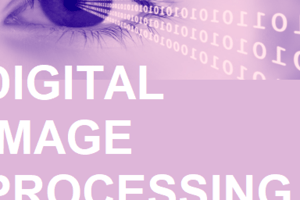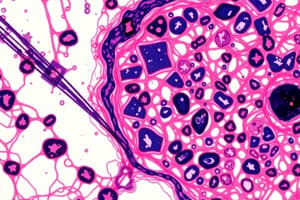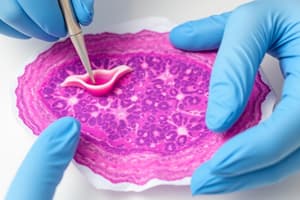Podcast
Questions and Answers
What is the primary goal of image enhancement in the context of human perception?
What is the primary goal of image enhancement in the context of human perception?
The primary goal of image enhancement is to improve pictorial information for better human interpretation and analysis.
How can noise filtering contribute to image quality?
How can noise filtering contribute to image quality?
Noise filtering can reduce unwanted variations in an image, thereby enhancing its clarity and overall quality.
Describe one technique used for contrast enhancement in images.
Describe one technique used for contrast enhancement in images.
A technique used for contrast enhancement is histogram equalization, which redistributes pixel intensity values to improve the contrast.
Why is deblurring important in image processing?
Why is deblurring important in image processing?
What role does image enhancement play in medical imaging, such as CT scans?
What role does image enhancement play in medical imaging, such as CT scans?
How can remote sensing benefit from image enhancement techniques?
How can remote sensing benefit from image enhancement techniques?
What is the significance of content enhancement in image processing?
What is the significance of content enhancement in image processing?
Can you provide an example of how image enhancement aids in quality control in industrial applications?
Can you provide an example of how image enhancement aids in quality control in industrial applications?
What is the primary purpose of image sequence processing in surveillance applications?
What is the primary purpose of image sequence processing in surveillance applications?
How can image processing techniques utilize infrared images?
How can image processing techniques utilize infrared images?
What role does image compression play in transmitting images over low bandwidth channels?
What role does image compression play in transmitting images over low bandwidth channels?
In automated inspection processes, what characteristics are examined to ensure product quality?
In automated inspection processes, what characteristics are examined to ensure product quality?
Describe how a coordinate system enhances the tracking of moving objects in image processing.
Describe how a coordinate system enhances the tracking of moving objects in image processing.
What is the significance of detecting surface characteristics such as uniformity in image processing?
What is the significance of detecting surface characteristics such as uniformity in image processing?
Explain how moving background object separation aids in security applications.
Explain how moving background object separation aids in security applications.
What types of applications benefit from boundary identification in image processing?
What types of applications benefit from boundary identification in image processing?
What are the three types of redundancy present in images?
What are the three types of redundancy present in images?
How does lossless compression differ from lossy compression in image processing?
How does lossless compression differ from lossy compression in image processing?
Explain the significance of the Bart lane system developed in the 1920s for image processing.
Explain the significance of the Bart lane system developed in the 1920s for image processing.
What impact did computer processing techniques have on image quality during the transmission of moon images in 1964?
What impact did computer processing techniques have on image quality during the transmission of moon images in 1964?
What are the two types of information stored in an image?
What are the two types of information stored in an image?
Describe the historical transition in printing methods for images from the 1920s to the 1940s.
Describe the historical transition in printing methods for images from the 1920s to the 1940s.
What are the applications of removing redundancy from images?
What are the applications of removing redundancy from images?
How did the ability to code 15 distinct brightness levels by 1929 impact image quality?
How did the ability to code 15 distinct brightness levels by 1929 impact image quality?
Flashcards
Image Processing
Image Processing
The process of manipulating digital images using a computer.
Image Enhancement
Image Enhancement
Improving image quality for better human perception.
Noise Filtering
Noise Filtering
Removing unwanted noise from images to improve clarity.
Contrast Enhancement
Contrast Enhancement
Signup and view all the flashcards
Machine Vision
Machine Vision
Signup and view all the flashcards
Medical Imaging
Medical Imaging
Signup and view all the flashcards
Remote Sensing
Remote Sensing
Signup and view all the flashcards
Terrain Image
Terrain Image
Signup and view all the flashcards
Image Redundancy
Image Redundancy
Signup and view all the flashcards
Pixel Redundancy
Pixel Redundancy
Signup and view all the flashcards
Coding Redundancy
Coding Redundancy
Signup and view all the flashcards
Psychovisual Redundancy
Psychovisual Redundancy
Signup and view all the flashcards
Lossless Compression
Lossless Compression
Signup and view all the flashcards
Lossy Compression
Lossy Compression
Signup and view all the flashcards
Bartlane System
Bartlane System
Signup and view all the flashcards
Digital Image Processing
Digital Image Processing
Signup and view all the flashcards
Image Processing in Industry
Image Processing in Industry
Signup and view all the flashcards
Boundary Information
Boundary Information
Signup and view all the flashcards
Video Sequence Processing
Video Sequence Processing
Signup and view all the flashcards
Movement Detection
Movement Detection
Signup and view all the flashcards
Image Compression
Image Compression
Signup and view all the flashcards
Automated Inspection
Automated Inspection
Signup and view all the flashcards
Window Tracking
Window Tracking
Signup and view all the flashcards
3D Coordinate System (Image)
3D Coordinate System (Image)
Signup and view all the flashcards
Study Notes
Image Processing
- Image processing is the manipulation of digital images by a computer
- Three key terms: Processing, Image, and Digital
- Need for image processing includes: improving pictorial information for human perception (e.g., image enhancement), use in autonomous machine applications (e.g., quality control, assembly), and efficient storage and transmission (e.g., quality control needs).
Human Perception
- Methods and techniques that enhance pictorial information for human interpretation and analysis
- Typical applications: noise filtering (e.g., image enhancement to improve image quality), content enhancement/contrast enhancement (e.g., increasing contrast for better image perception), and deblurring (e.g., defocused lens correction)
- Medical imaging (e.g., CT scans, ultrasounds)
Remote Sensing
- Aerial images or satellite images used for prediction or research. Examples include studying environmental changes (e.g., rivers), identifying fire regions (e.g., Borneo fires), and weather forecasting.
Machine Vision Applications
- Procedures for extracting image information for computer processing (visualization perception).
- Typical applications include automated industrial machine vision for product assembly and inspection, automated target detection and tracking, finger print recognition, processing aerial/satellite imagery for weather prediction and crop assessment.
- Automated inspection, e.g., bottling plant automation (checking if bottles are correctly filled)
Boundary Information
- Identifying boundaries(e.g., length/width).
- 2D projection of images.
- Dimension/Angle of a particular image.
- Surface characteristics of images (uniform or non-uniform). Components to consider: Corners, Angles, and Dimensions.
- For tolerance limitations, analyze boundary issues, identify objects based on defects, and inspect items (e.g., IC manufacturing) based on texture analysis.
Video Sequence Processing
- Emphasizes detecting moving parts in images.
- Example applications that use detection of moving parts in image sequences: security surveillance, finding trajectories of moving targets, monitoring organ boundaries (medical applications).
- Movement detection includes separating moving objects from backgrounds in images or video sequences, enhancing imagery with varied lighting conditions (e.g., sun, night, infrared, thermal), and correcting/improving image clarity (e.g., through image processing techniques).
- Tracking moving objects using image processing or video processing sequences, coordinate systems, and utilizing multiple cameras for 3D systems such as Azimuthal and Elevation.
Image Compression
- Images typically contain redundancy which can be exploited for compression.
- Reducing storage space required and transmission bandwidth.
- Intensity of an image is determined from neighboring intensity values (redundancy). Techniques include pixel redundancy, coding redundancy and psychovisual redundancy
- Three types of redundancy can be present in images: pixel, coding and psycho-visual. Removing these will leave only the necessary information, reducing storage and bandwidth requirements.
- Applications: reduction in storage space and reduction in required bandwidth to transmit the image.
Lossy and Lossless Compression
- Lossless compression: Removing redundancy from image, maintaining all original data
- Lossy compression: Removing redundancy and some information while achieving reasonable/acceptable image quality; naturally resulting in a certain loss/distortion when reconstructing the original image
History of Image Processing
- 1920s: Submarine cables used for transmitting digitized newspaper pictures. Specialized equipment used for coding and transmitting. This led to telegraphic printers.
- 1921: Printing procedure was modified to photographic reproduction from tapes, to improve quality and resolution
- 1929: Increased to 15 levels, improving picture quality.
- 1964: Computer processing techniques applied in space exploration (e.g., Ranger 7 images of the moon)
Digital Image
- Digital image = a multidimensional array of numbers (intensity image) or vectors (color image).
- Each component in an image (called a pixel) is associated with its own value.
Image Representation
- An image is a two-dimensional signal that varies over spatial coordinates (x, y), which can be represented mathematically (f(x, y)).
- In sunlight, light objects reflect in different ways; giving a continuous range of intensity values varying from zero to infinite (min. and max. values).
Image Acquisition
- A physical device (sensitive to specific bands of electromagnetic energy), such as an X-ray machine, an ultraviolet light sensor/scanners, MRI or PET machines, is used to acquire imagery.
- The resulting electrical signal from the device is converted to a digital form.
Storage
- Three types of image storage options exist - short term, online storage, and archival storage
- Short term involves using computer memory for instantaneous image use/processing (e.g., frame buffer within displays and storage on memory cards - 32 Mbytes).
- Online storage provides images for relatively faster recall, such as magnetic disks, winchester disks and magneto-optical (MO) storage.
- Archival allows for large storage amounts with infrequent access, such as high density magnetic tapes (e.g., 6400B/in). Other examples include write-once-read-many (WORM). Storage characteristics determine the appropriate system selection.
Processing
- Image processing algorithms are commonly run within software or a combination of software and hardware. Software algorithms were historically the dominant implementation method.
- Hardware implementations have improved speed, sometimes necessary for specialized applications like low light microscopy.
- More comprehensive systems incorporating both hardware and software have become increasingly common.
Image Processing Systems
- 1980s-1990s single-board systems designed for industry standards allowed for use in PCs and workstations.
- Used digitizers and frame buffers coupled with ALU chips (arithmetic logic unit)
- Commercially available systems typically include support for other software and graphics tools.
Communication
- Image transmission may be done using a 9.6 kbps modem
- Data compression is often used to improve transmission time.
Display
- Image display often uses cathode ray tubes (CRTs).
- Image may also be printed.
Studying That Suits You
Use AI to generate personalized quizzes and flashcards to suit your learning preferences.




